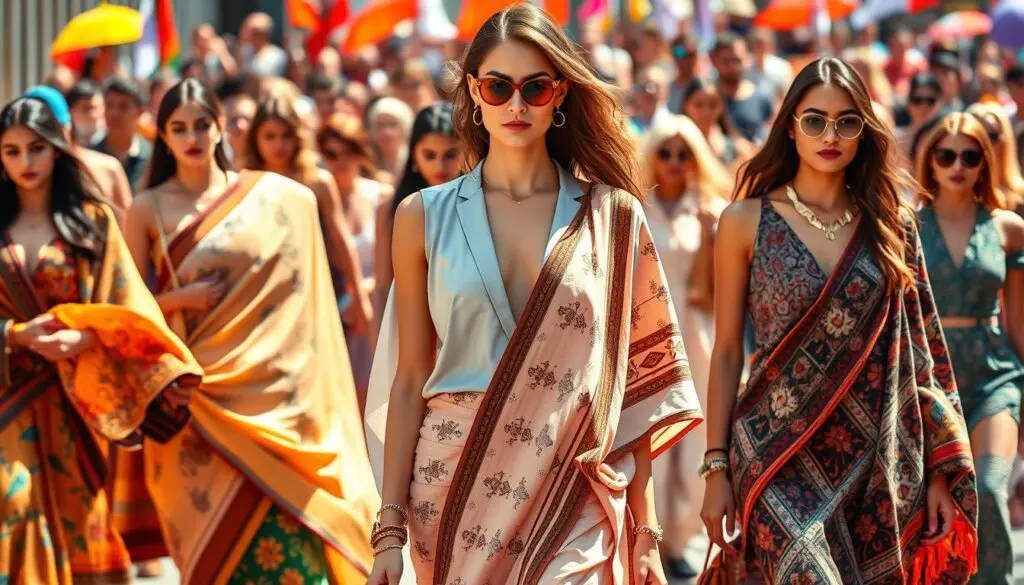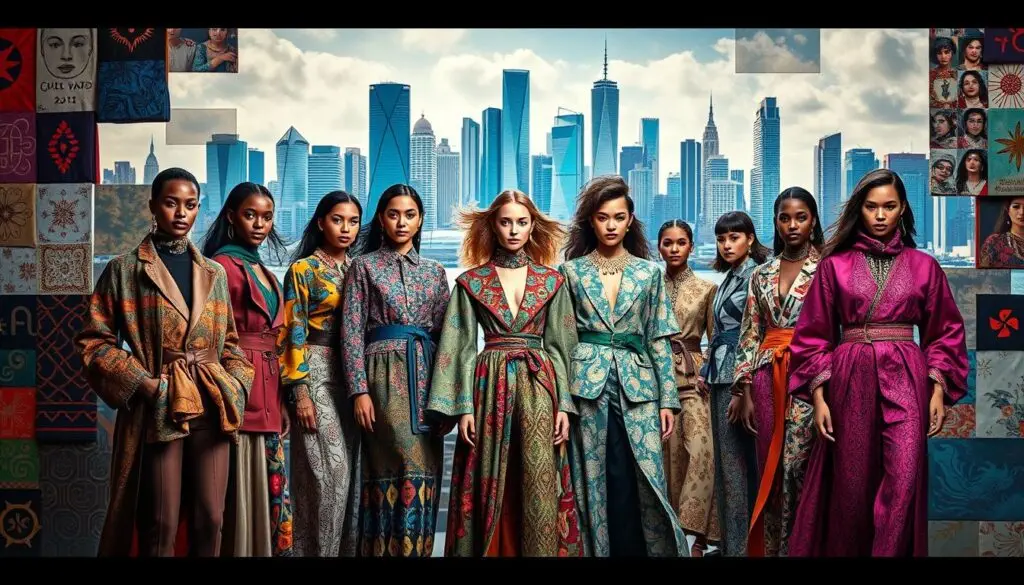Fashion is a universal language that speaks volumes about our culture and individual identity. As the industry continues to evolve, it becomes a canvas where diverse styles and traditions blend.
The contemporary landscape is shaped by a rich tapestry of cultural influences, creating a melting pot of styles that transcend geographical boundaries. Globalization has transformed the way we experience fashion, making it a powerful medium of cultural expression and identity formation.
As we look to the future, the fusion of traditional elements with modern aesthetics will continue to drive innovation in the industry, celebrating diversity and promoting a global consciousness.
The Interplay Between Culture and Fashion Identity
The dynamic relationship between culture and fashion plays a significant role in shaping individual and collective identities. Fashion serves as a visual language that communicates cultural affiliations, personal values, and social identities.
Personal and Collective Identity Formation
Fashion and culture are intimately associated, reflecting social norms, political events, and economic conditions. A person’s clothing choices convey their identity, beliefs, and opinions, which in turn shape the culture. Traditional clothing is a poignant manifestation of cultural expression, imparting unique identities, beliefs, and historical legacies.
Cultural identity is both expressed and reinforced through fashion choices, creating a cyclical relationship where clothing reflects and shapes cultural values. In multicultural societies, fashion becomes a powerful tool for navigating different cultural identities and expressing hybrid or fluid cultural affiliations.
The democratization of fashion through social media has allowed diverse cultural expressions and identities to gain visibility and influence in the global fashion conversation. As individuals craft their identities in a globalized world, fashion provides a canvas for exploring cultural roots while embracing cosmopolitan influences.
The interplay between personal style choices and cultural context reveals how fashion functions as both a mirror reflecting cultural values and a hammer shaping new cultural norms. This complex interaction underscores the significance of understanding the cultural influences on fashion identity.
Cultural Influences in Contemporary Fashion: Impact on Designers
The contemporary fashion landscape is significantly shaped by cultural influences that inspire designers worldwide. The global fashion industry thrives on exploring diverse styles, which in turn, steers trends and aids designers in their artistic endeavors. Fashion throughout history has been a reflection of cultural mores, values, and artistic movements.

The extent to which culture influences fashion has significantly expanded in the modern era due to globalization and digital media. Designers incorporate elements from various cultures into their creations through the use of religious emblems, historic materials, and the latest ecological trends. This cultural infusion provides designers with rich sources of inspiration, leading to innovative silhouettes, unexpected color combinations, and novel textile applications.
Ethical Considerations in Cultural Borrowing
Many designers engage in extensive research to understand the historical and cultural significance of the elements they incorporate, ensuring respectful and informed creative processes. The line between cultural appreciation and appropriation remains a critical consideration for designers working with influences outside their own cultural backgrounds. Collaborative approaches between designers and artisans from specific cultural traditions can create mutually beneficial relationships that preserve heritage crafts while creating contemporary relevance.
Fashion houses increasingly recognize the importance of cultural consultants and diverse design teams to ensure sensitive and accurate cultural references in their collections. By balancing authenticity and innovation, designers can honor traditional elements while reimagining them for contemporary contexts. This approach not only fosters creativity but also promotes cultural understanding and respect within the fashion industry.
Traditional Attire as Cultural Heritage in Modern Fashion
Traditional attire is more than just historical clothing; it embodies the cultural values, social hierarchies, and collective memories that shape contemporary fashion. Its elaborate colors, patterns, and motifs weave together experiences and tales passed down through generations, serving as a visible symbol of cultural identity.
Modern designers are finding innovative ways to incorporate elements of traditional garments into contemporary collections, creating pieces that bridge past and present. This revival of traditional textiles and techniques not only preserves cultural heritage but also introduces sustainable practices into modern fashion production.
Revival of Traditional Craftsmanship
The adaptation of traditional garments for contemporary markets raises important questions about cultural ownership and commercialization. However, when done thoughtfully, it can also promote cultural heritage and support traditional craftsmanship. Consumers are increasingly seeking clothing that connects them to cultural narratives and authentic craftsmanship, moving away from mass-produced fast fashion.
By honoring the original cultural context and making thoughtful modifications, the most successful modern adaptations of traditional attire ensure relevance for today’s wearers. Museums, fashion archives, and cultural institutions play crucial roles in documenting and preserving traditional attire, making these resources accessible to contemporary designers.
Evolution of Fashion Trends Across Global Cultures
As cultures intersect, fashion trends evolve, reflecting the dynamic nature of global cultural exchange. The rich tapestry of fashion around the world is woven from threads of diverse cultural influences, historical backdrops, and customs. This diversity has led to a fascinating evolution of styles and trends.
The traditional Japanese kimono, for instance, has undergone significant transformations, influencing contemporary fashion, particularly streetwear. Similarly, the Indian sari has become a global fashion phenomenon, transcending national boundaries. African fabrics and patterns, known for their brightness and cultural significance, have been incorporated into high-end collections by global fashion designers.

Digital media platforms have played a crucial role in democratizing fashion trend dissemination. This has allowed styles from previously marginalized cultures to gain international visibility and influence. The acceleration of globalization has intensified cross-cultural fashion influences, creating hybrid styles that blend elements from multiple cultural traditions.
Regional fashion centers beyond traditional Western capitals are increasingly setting global trends. Cities like Tokyo, Seoul, Lagos, and Mumbai showcase distinctive cultural perspectives, contributing unique elements to the global fashion conversation. The most enduring cross-cultural fashion trends are those that respectfully adapt elements while understanding their cultural significance.
The evolution of fashion trends across cultures reflects broader patterns of cultural exchange, power dynamics, and shifting social values. Contemporary fashion increasingly embraces cultural diversity, with consumers seeking authentic connections to various cultural aesthetics. This shift towards cultural appreciation is shaping the future of global fashion trends.
Technology and Sustainability in Culturally-Influenced Fashion
With growing awareness of environmental issues, the fashion industry is turning to technology and sustainable practices to preserve cultural fashion traditions. The use of advanced technologies is enabling new approaches to celebrating cultural heritage while making it relevant for contemporary consumers.
The production process in the fashion industry is being transformed by the incorporation of sustainable materials and techniques. Designers are revolutionizing the way fashion is approached from an ecologically conscious standpoint. This shift is driven by the growing importance of sustainability and ethical production practices in the industry.
Sustainable Practices Inspired by Traditional Methods
Many traditional cultural practices in fashion production inherently embody sustainable principles. For instance, indigenous communities possess generational knowledge about working with local, natural materials in ways that minimize environmental impact. The slow fashion movement draws inspiration from cultural traditions that value quality craftsmanship, longevity, and emotional connection to garments.
Technologies such as 3D printing and digital fabrication methods offer opportunities to recreate complex cultural patterns and designs with precision while reducing material waste. Virtual and augmented reality technologies allow consumers to experience cultural fashion heritage in immersive ways, creating a deeper appreciation for diverse fashion traditions.
By embracing both technology and traditional methods, the fashion industry can move towards a more sustainable and culturally rich future. The intersection of technology, sustainability, and cultural heritage in fashion represents a promising path toward a more ethical and environmentally responsible industry.
The Future Landscape of Cultural Fashion Fusion
The future of fashion is deeply intertwined with the cultural tapestry that inspires it, driving innovation and diversity. As the industry continues to evolve, we can expect to see even greater cultural fusion, facilitated by digital connectivity and collaboration among designers worldwide.
Emerging technologies like AI and virtual reality will enable new forms of cultural expression in fashion, allowing for unprecedented experimentation with cultural elements. Future fashion brands will need to balance global appeal with cultural authenticity, creating designs that resonate across markets while respecting cultural origins.
Balancing Global Appeal with Cultural Authenticity
To achieve this balance, brands will need to engage in transparent storytelling about the cultural influences behind their designs. The next generation of fashion designers will approach cultural influences with greater sensitivity and nuance, moving beyond surface-level aesthetics to deeper engagement with cultural contexts.
As the fashion industry continues to evolve, cultural influences will remain a vital source of inspiration, driving innovation and shaping the future of fashion.




